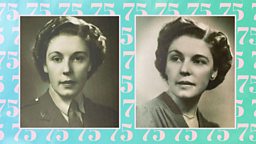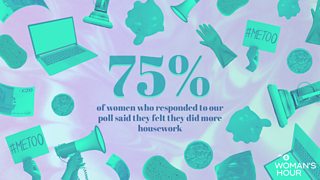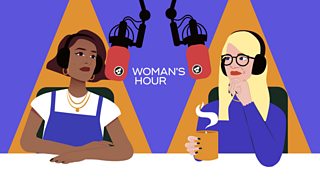A cup of tea with Woman’s Hour’s 104-year-old former producer
As Woman’s Hour celebrates its 75th anniversary, presenter Emma Barnett went to have a cup of tea with one of the first producers of the programme, 104-year-old Diana Gayford.

“I was very excited to be on Woman’s Hour and then I was very upset that we really only had to deal with domestic matters at first. I felt women had gone past that. It was some cookery recipes because food rationing was still on, hairdressing, fashion, childcare and that was about it. All domestic items.”
To mark the 75th anniversary of Woman’s Hour, presenter Emma Barnett went to have a cup of tea with one of the first producers of the programme, 104-year-old Diana Gayford.
Diana had joined the Â鶹ԼÅÄ following the Second World War where she had been a Senior Commander in the Auxiliary Territorial Service, the women’s branch of the British Army.
She was in her late twenties when she was assigned to work on a new Â鶹ԼÅÄ radio programme called Woman’s Hour, which was first broadcast on 7 October 1946. The fact that the first presenter of the programme was a man, Alan Ivinmey, struck Diana as “extremely strange”, but she “hadn’t been at the Â鶹ԼÅÄ for very long, so I kept my mouth shut a bit on that one.”
It was extremely strange that Woman’s Hour was first presented by a man.
Recalling the hour-long programme, Diana says it was split into “talks” by contributors and then the last 15 minutes was a “story”. Guests were often people Diana knew or people her colleagues knew, or people who sent in “scripts”.
“When they sent in scripts, I sent for them to have them voice tested, first of all, and many of them used to say, ‘I'm so used to public speaking’. And I used to say, well, you must forget all of that because the spoken word in broadcasting is completely different. And very often we had to revise the script because they were writing for the written word and not the spoken word. So that took quite a lot of time. And then if their voice was all right, we had to rehearse it and time it almost to the second, certainly to the minute. Otherwise you got into terrible trouble.”

Photos: Diana Gayford in the ATS in 1942 and “in civvies” in 1942. Diana joined Woman’s Hour in 1946. Photos courtesy Diana Gayford.
Woman’s Hour was at 2pm in the late 1940s, rather than 10am as it is today. The afternoon slot was a time when, according to Diana, “a lot of women who weren't working would be at home”. Brimming with frustration about only covering domestic items, she decided to ask her boss if they could also have items about careers, “because I thought that women sitting at home might be interested in careers for their daughters and also possibly part-time work for themselves.”
Eleanor Roosevelt was absolutely lovely.
“Several of us really got at Norman Collins [the creator of the programme]. And he did agree that I could have career talks and then other producers managed to get him to have other things. I remember I wanted something on simple economics and had great difficulty. I could get a Labour woman very easily, but the Conservatives weren't able to produce anyone with much ease, which was quite interesting.”
The most famous guest Diana remembers during her time at Woman’s Hour was Eleanor Roosevelt, the wife of American President Franklin D. Roosevelt. “She was absolutely lovely. She insisted on being introduced to all the other producers and to the engineers who were sitting, organising things. And most people just ignored the engineers and only were interested in the producers.
In those days, we were informing women. Now we’re asking women about things more.
“I was very excited to meet her because I was with other people and we all sat around and she sort of more or less said, well, what do you want me to say? She was talking to the women of England and what they'd done in the war and that sort of thing. She was gentle with us.”
Asked whether she thought the Â鶹ԼÅÄ felt the benefit of seeing the world through a woman’s lens, Diana is sure that they did.
“I think some of the top people in the Â鶹ԼÅÄ weren't all that keen on women, but some of the others were very helpful and supportive indeed, and I think listeners were very pleased to have us because they used to write letters in sometimes.”
Woman’s Hour today is quite different from her time as a producer on the programme, Diana says. “In those days, we were informing women about things. And I would say from the little, few programmes I've listened to, we're now asking women about things more and interviewing them and asking them to say what they feel, whereas it was different before.”

Photo: T. Holland Bennett interviewing guests on Woman’s Hour in 1946
When asked by Emma Barnett about what she would say to those people who argue that we shouldn't and don't need a programme called Woman's Hour anymore? Diana says they are being “rather unrealistic”.
I was very upset about having to give up my career.
“I think although women can join every kind of activity these days and every kind of job, we are still interested in certain women's things. And there are still things that don't apply to men after all.”
Diana left Woman’s Hour after a couple of years on the programme when she moved to Germany with her husband for his job. She revealed that she resented having to give up her career. “I didn't let my husband think about it too much because he was a very kind man. It would have upset him. But I was very upset. And, of course, when I got back to England after about three years with a small child, it would have been very difficult to go back into work again.”
Her advice for the current Woman’s Hour team? “Believe that women are interested in everything, absolutely everything. There's nothing that we're not interested in, I’m quite sure.”
Listen to Diana Gayford’s full interview with Emma Barnett via Â鶹ԼÅÄ Sounds, where you can also catch up with any of the other episodes of Woman’s Hour you may have missed. Follow us @bbcwomanshour on or to join the conversation.




